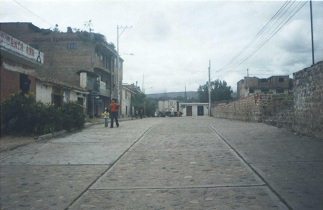 |
 Plaza
Santa
Ana, row of houses Plaza
Santa
Ana, row of houses
To the left there
is a row of houses one or two floors. The
impression is misleading a little bit. The houses
mostly have other floors beneath on the slope. The
floor which can be seen from the road is only the
one on the top.
The pavement is made of cobblestone in cement so
the cars cannot be fast. For bikers it's not so
comfortable...
|
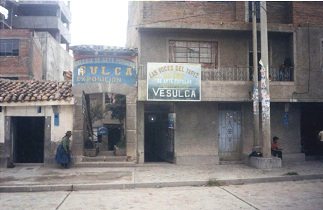 |
 Plaza
Santa
Ana, another entrance door to artisan Sulca Plaza
Santa
Ana, another entrance door to artisan Sulca
The Sulca family
did much for the reputation of the quarter of
Santa Ana. But until today there is no central
office for example where one could get the
information who is producing what and where.
|
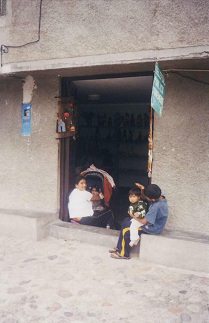 |
 Plaza
Santa
Ana, daughter of artisan Sulca in an entrance Plaza
Santa
Ana, daughter of artisan Sulca in an entrance
The inhabitants of
Santa Ana have something comfortable: Often they
stonewall little benches outside on the house
front where everybody can take a rest and have a
little talk. This shows a basic confidence which
is not existing any more in other parts of the
town.
|
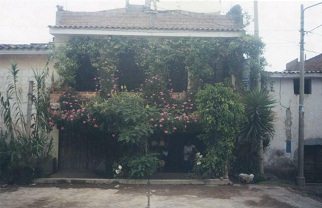 |
 Plaza
Santa
Ana, the house of the Gallardo family, artisan Plaza
Santa
Ana, the house of the Gallardo family, artisan
The house has got
many floors. Until the 1980s the house was a
little hotel. By the outbreak of the terror times
in the 1980s tourism broke down and the family
changed the house into a gallery. Today one could
reopen and refurnish the house for a hotel but
5,000 Soles are missing (about 1,800 "US" Dollars,
about 1,300 Euros), because furniture cost a lot
in the Sierra because there is no big forest in
the region and because people are poor. They
hardly have furniture and by this there is not
much second hand furniture.
|
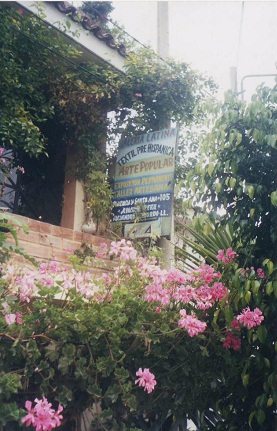 |
 Plaza
Santa
Ana, the house of the Gallardo family, advertising
sign Plaza
Santa
Ana, the house of the Gallardo family, advertising
sign
Also the
advertising sign of the Gallardo family is covered
by plants so one has to look for it. There is
missing the marketing in the thinking to make some
good promotion.
|
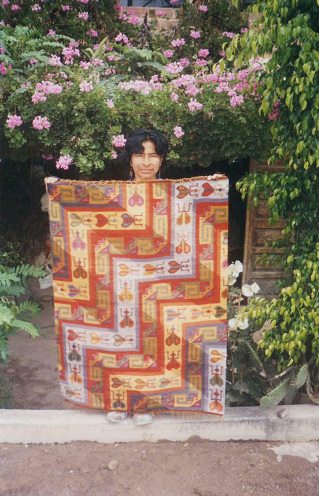 |
 Mrs.
Gallardo
showing one of her tapestries (span. tejido) Mrs.
Gallardo
showing one of her tapestries (span. tejido)
Such a tapestry needs about 3 months of disciplined
work on the loom.
Family Gallardo, Plazuela de Santa Ana no. 105,
Ayacucho, Perú, Tel. 0051-(0)66-31 12 15. |
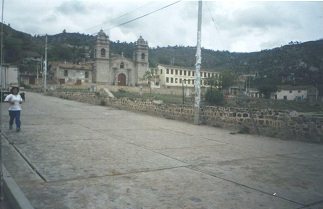 |
 Only
now
one can see the whole church, "Santa Ana" church Only
now
one can see the whole church, "Santa Ana" church |
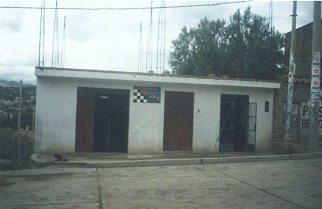 |
 The
neighboring
house besides the Gallardo family The
neighboring
house besides the Gallardo family
This house with it's high posts on the roof is
waiting for the construction of another floor when
enough money is saved.
|
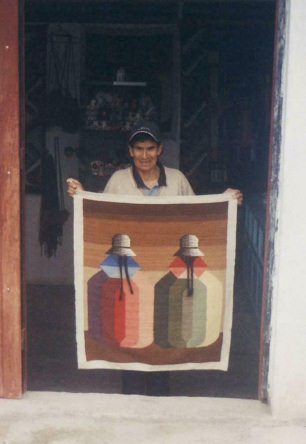 |
 Neighbor
Honorato
showing one of his tapestries (span. tejido) Neighbor
Honorato
showing one of his tapestries (span. tejido)
Also for this tapestry was needed about 3 months
work on the loom.
Honorato Oncebay Coras, Plazuela de Santa Ana no.
42, Ayacucho, Perú
|
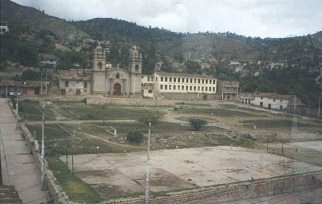 |
 "Santa
Ana"
church with it's square, sight from the roof of the
house of the Gallardo family "Santa
Ana"
church with it's square, sight from the roof of the
house of the Gallardo family
Behind the church
on the slope there are a lot of more houses with
artisan's families. Partially they are only
reachable by foot. One can hardly believe that in
such poor houses is produced handicraft.
The inhabitants
need a coordination office but they don't know how
to do it because nobody has an idea of promotion
and marketing.
|
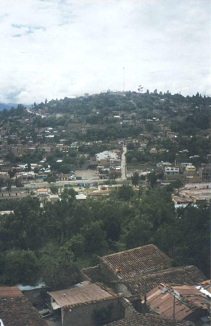
|
 Sight
from
"Santa Ana" from the house of the Gallardo family to
Ayacucho 01 Sight
from
"Santa Ana" from the house of the Gallardo family to
Ayacucho 01
|
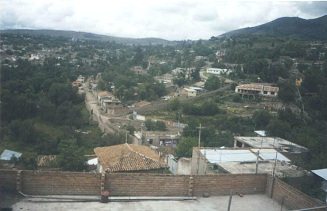
|
 Sight
from
"Santa Ana" from the house of the Gallardo family to
Ayacucho 02 Sight
from
"Santa Ana" from the house of the Gallardo family to
Ayacucho 02 |